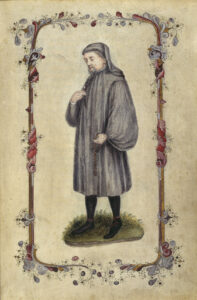 The London Life of Geoffrey Chaucer: A
The London Life of Geoffrey Chaucer: A
Glimpse into Pilgrimage during the Middle
Ages
by Eamonn Mullally
Geoffrey Chaucer, often heralded as the father of English literature, spent a
significant portion of his life in London, a city that played a pivotal role in shaping his literary
works. Born in the early 1340s, Chaucer’s connection to London was not just that of a
resident, but also of a keen observer and an active participant in the vibrant life of the city.
One of the fascinating aspects of Chaucer’s London life was his association with both
pilgrimage and the vintners, two elements that deeply influenced his writing and provided a
rich tapestry of characters and narratives.
The concept of pilgrimage held a special place in medieval society, serving as both a
spiritual journey and a social event. Pilgrimages to holy sites were common, with individuals
from various walks of life coming together for a shared purpose. Chaucer himself was no
stranger to this practice, and it is vividly depicted in his most famous work, The Canterbury
Tales. This collection of stories, told by a diverse group of pilgrims on their way to the shrine
of Saint Thomas Becket in Canterbury, offers a window into the medieval mindset, revealing
the hopes, fears, and aspirations of the time.
In The Canterbury Tales, Chaucer masterfully captures the essence of pilgrimage,
portraying it as a microcosm of society. The tales are not just religious in nature; they
encompass a range of human experiences and emotions, from the noble to the bawdy, the
pious to the irreverent. Through his pilgrims, Chaucer presents a panorama of medieval life,
each character bringing their unique perspective and story to the journey. This narrative
technique allows Chaucer to explore various themes and social issues, making The
Canterbury Tales a timeless reflection on human nature.
Another intriguing aspect of Chaucer’s life was his connection to the vintners,
the merchants of wine. Chaucer’s father, John Chaucer, was a successful vintner and a
member of the powerful Vintners’ Company, one of the city’s prominent guilds. This affiliation
provided young Geoffrey with a unique insight into the world of trade and commerce,
experiences that would later find their way into his writing. The bustling trade in wine and
other goods in London’s markets offered Chaucer a rich source of inspiration for his
characters and settings.
Chaucer’s familiarity with the vintners’ trade is evident in his works, where references to wine
and the social dynamics of the marketplace appear frequently. The vivid descriptions of
taverns and the interactions between merchants and their clients showcase Chaucer’s keen
observation skills and his ability to weave everyday life into his literary creations. The
Vintners had ships moving frequently between the south coast England and the ports of
southwest France that moved pilgrims to join the Camino de Santiago as well as wool to
France, in return for fine wines. This blend of the mundane and the extraordinary is a
hallmark of Chaucer’s writing, providing readers with a realistic yet captivating portrayal of
medieval life.
Beyond his literary contributions, Chaucer’s life in London was marked by his
involvement in various civic duties and government positions. He served as a courtier,
diplomat, and civil servant, roles that brought him into contact with the city’s elite and the
workings of government. These experiences enriched Chaucer’s understanding of human
nature and the complexities of social hierarchy, further informing his writing.
Chaucer’s London was a city of contrasts, a place where the sacred and the secular
coexisted, where the grandeur of the royal court met the bustling energy of the marketplace.
It was a city that inspired and nurtured Chaucer’s literary genius, providing him with a wealth
of material to draw upon. Through his works, Chaucer immortalized the spirit of London,
capturing the essence of its people and their stories in a way that continues to resonate with
readers today.
The London life of Geoffrey Chaucer was a tapestry woven with pilgrimage and the
vintners’ trade, elements that profoundly influenced his literary output. His experiences in
this vibrant city, coupled with his keen observational skills and deep understanding of human
nature, allowed Chaucer to create works that are celebrated for their richness, diversity, and
timeless relevance. As we delve into Chaucer’s writings, we gain not only an appreciation for
his literary genius but also a glimpse into the life and soul of medieval London, a city that
shaped and was shaped by one of its most illustrious inhabitants.
To discover more about the ancient connection between London and Pilgrimage join
Eamonn on his new walk: Pilgrims through Medieval London.
Picture credit “Geoffrey Chaucer – Canterbury Tales (1478), frontispiece – BL” is marked with CC0 1.0.
